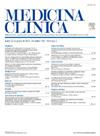纤维肌肉发育不良和节段性动脉介质溶解的临床谱和治疗策略:一项队列研究
IF 2.1
4区 医学
Q1 MEDICINE, GENERAL & INTERNAL
引用次数: 0
摘要
节段性动脉介质溶解(SAM)和纤维肌肉发育不良(FMD)是罕见的血管病变。由于它们的相似性,区分它们是困难的。目的是描述和比较临床特征、表现症状、诊断测试、治疗和结果。患者和方法2016年至2023年间诊断为口蹄疫或SAM的患者的单中心回顾性分析。结果共纳入4例SAM患者和18例FMD患者。男性以腹痛为主(75%),年轻女性以FMD为主(61.1%),伴有神经系统症状(66.6%)。抗凝治疗是SAM的主要治疗方法,抗血小板治疗是FMD的主要治疗方法。手术治疗分别占25%和22.2%,经皮介入治疗分别占27.7%和无一例。在随访期间(中位3.4年),两组的死亡率相似(10%)。结论两种疾病的临床表现、治疗和结局存在关键差异,可能有助于指导两种疾病的治疗。本文章由计算机程序翻译,如有差异,请以英文原文为准。
Clinical spectrum and therapeutic strategies of fibromuscular dysplasia and segmental arterial mediolysis: A cohort study
Introduction
Segmental arterial mediolysis (SAM) and fibromuscular dysplasia (FMD) are rare vasculopathies. Differentiating between them is difficult due to its similarities. The aim is to describe and compare the clinical characteristics, presenting symptoms, diagnostic tests, treatment, and outcomes.
Patients and methods
Single center retrospective review of patients diagnosed with FMD or SAM between 2016 and 2023.
Results
Four patients with SAM and 18 with FMD were included. SAM predominated in males with abdominal pain (75%), while FMD in young women (61.1%) with neurological manifestations (66.6%). Anticoagulation was the main treatment for SAM, and antiplatelet therapy for FMD. Surgical treatment was performed in 25% and 22.2%, while percutaneous intervention was performed in none and 27.7% of patient, respectively. During follow-up (median 3.4 years), mortality was similar in both groups (10%).
Conclusion
There are key differences in clinical presentation, management, and outcomes that may help guide the treatment of both conditions.
求助全文
通过发布文献求助,成功后即可免费获取论文全文。
去求助
来源期刊

Medicina Clinica
医学-医学:内科
CiteScore
3.10
自引率
5.10%
发文量
295
审稿时长
22 days
期刊介绍:
Medicina Clínica, fundada en 1943, es una publicación quincenal dedicada a la promoción de la investigación y de la práctica clínica entre los especialistas de la medicina interna, así como otras especialidades. Son características fundamentales de esta publicación el rigor científico y metodológico de sus artículos, la actualidad de los temas y, sobre todo, su sentido práctico, buscando siempre que la información sea de la mayor utilidad en la práctica clínica.
 求助内容:
求助内容: 应助结果提醒方式:
应助结果提醒方式:


